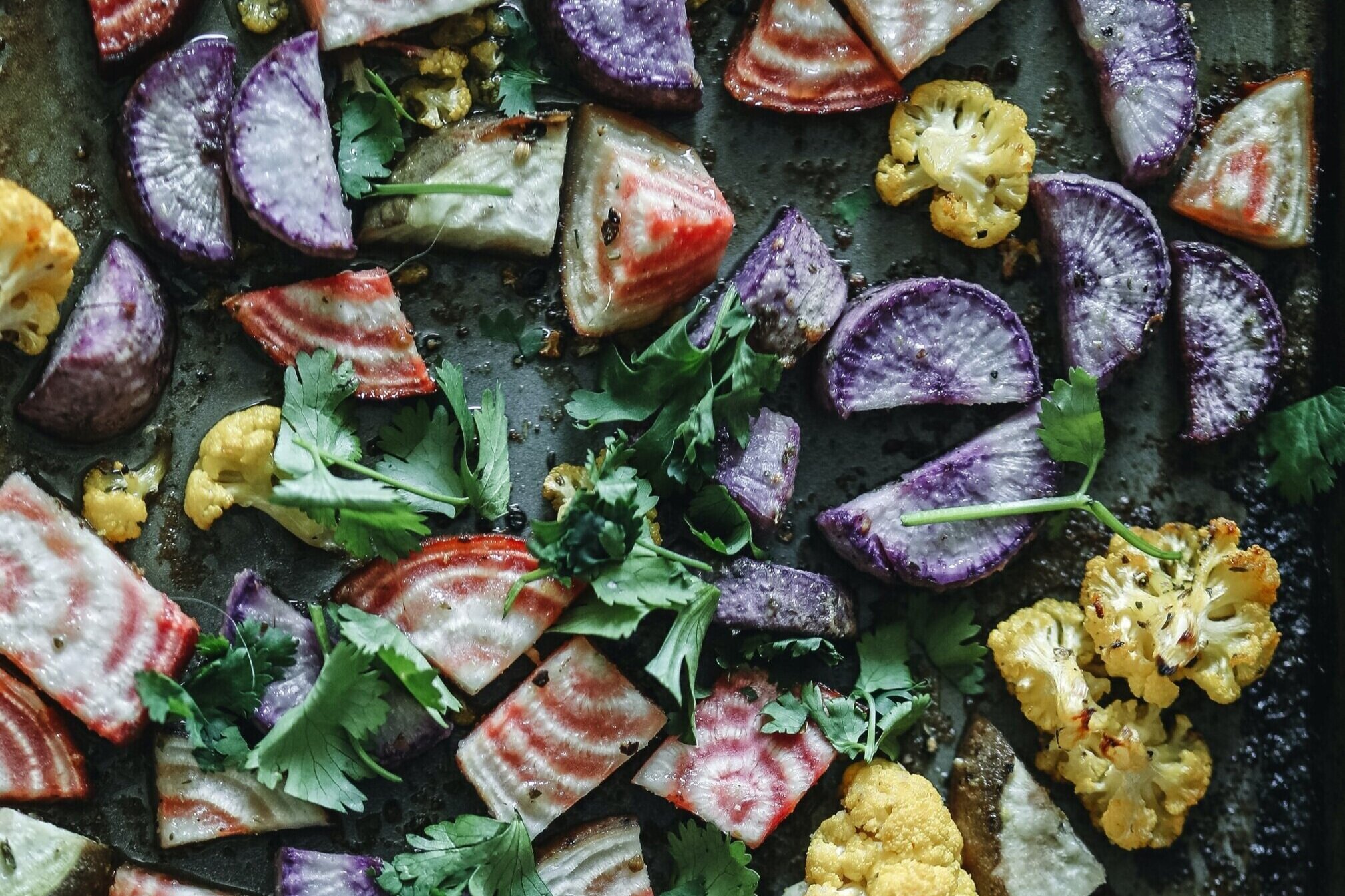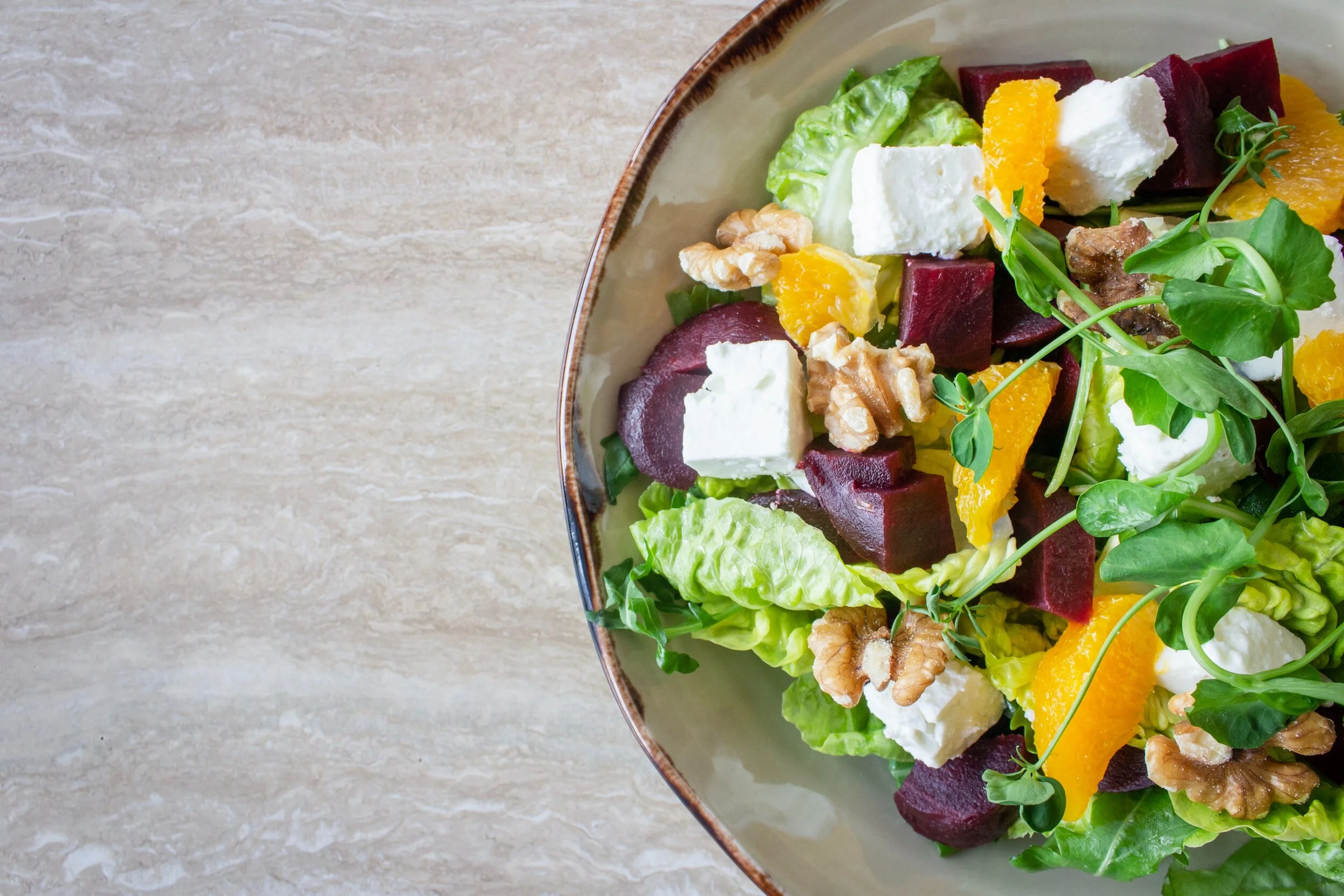Wine Pairings for Fall Ingredients
Roasted beets, courtesy of Edgar Castrejon for Unsplash
These are the bottles to sip alongside what’s cropping up this season.
Tomatoes, corn and berries have given way to pumpkins, parsnips and pears. As we acclimate to the cooler weather our palates are craving the root veggies, earthiness and crisp tree fruits that are everywhere right now.
In general, the fruits and vegetables that are on shelves and in stalls right now aren’t shy like wallflowers but big and bold, according to Dustin Tanski, lead concierge Spirits & Spice, a wine and gourmet shop with four locations around the U.S. “[These are ingredients] not likely to be overwhelmed or competing with wines,” he points out. He recommends cooler-climate grown bottles--which tend to have higher acidity levels and lower residual sugar as well as earthiness or minerality--with the ingredients and cooking techniques found in cooler weather dishes. “Higher acidity produces a mouth-watering effect and balances rich, creamy foods, [while] lower sugar and higher acidity in wine highlight bright fruits and vegetables like apples and fennel.”
At the onset of cooler weather, Ted Rink, beverage director at BLVD Steakhouse in Chicago, finds himself turning to Old World reds, especially those from France’s Rhône Valley. Wallet-friendly options include Côtes du Rhône or Côtes du Rhône Village, while producers from Côte-Rotie or Hermitage offer a bit of an upgrade. Wines from the northern crus of the Rhone are powerful syrah dominant, he says, like Cornas, Cote-Rotie or Hermitage, while the those from the grenache-dominant southern Rhône including Chateaunuef-du-Pape, Gigondas and Vacqueyras are still full-bodied yet more fruit-forward.
Here are some specific pairings for dishes with seasonal produce:
Pumpkin soup, courtesy of Monika Grabkowska for Unsplash
Pumpkin / Squash
Pumpkin soup, butternut squash risotto and slices of roasted delicata squash drizzled with olive oil: all share a mild, sweet, earthy flavor and creamy texture. “Seek out wines that have a round texture, ripe fruit character, and subtle hard spice notes,” advises Master Sommelier Nick Hetzel, who also serves as national director of wine education for Jackson Family Wines. “The sweet fruited aspects of a Mosel Riesling can [also] play into those elements of pumpkin and squash,” says Rink, “[whose] acidity on the finish cleans up the palate and resets for the next bite.”
Try:
Sidewood Estate Pinot Gris 2019 ($17) from Adelaide Hills, Australia, with honeysuckle and citrus, restrained acidity and an elegant mouthfeel. This wine won a Silver medal at the 2020 BIWC.
Cellier des Dauphins Réserve Côtes du Rhône ($15), a grenache and syrah blend with notes of black fruit and soft tannins that was a Bronze medal winner at the 2019 NYIWC.
Heinz Eifel Riesling Kabinett Mosel 2018 ($12), well-balanced, young, fresh and fruity, with crispy acidity, peach and citrus and slight sweetness.
Fennel
The bulb and fronds of this vegetable that is a relative of the carrot (but grows above, rather than under, the ground) are both incredibly aromatic. Even if you aren’t a fan of licorice you can still cozy up to shaved fennel salad, braised baby fennel and pasta with sausage and fennel, especially since the anise tones turn more subtle when fennel is braised or roasted. Adam Judeh, general manager and wine expert at Fond Restaurant in Philadelphia, recommends “a pinot grigio that’s light and crisp and a little floral.” The minerality, great acidity and white pepper of grüner veltliner can also be a fun option.
Pomegranates, courtesy of Nathalie Jolie for Unsplash
Try:
Weingut Baumgartner Grüner Veltliner Selektion 2019 ($19), with a pleasingly dry palate with hints of pear and citrus and clean finish; this wine won a Double Gold medal at the 2020 BIWC.
Bella Vita Pinot Grigio 2019 ($11), bright and lively with stone fruit, citrus and a touch of florality.
Titento Pinot Grigio 2018 ($16), refreshing and easy-drinking with citrus fruit and Granny Smith apples; this wine was named Italian Pinot Grigio of the Year at the 2019 NYIWC.
Apples / Pears
While these fruits are staples for fall desserts like cobblers, tarts and pies, they also show up in savory fare; think seared duck breast with pears, cider-braised pork loin and endive salad with thinly-sliced pears and shallot/cider vinaigrette. Pour white wines that share the fruits’ crisp fresh flavor and sweet-tart acidity.
Try:
August Kesseler Riesling R 2019 ($18.99), fruity, mineral-driven and well-balanced with ripe apples and peaches and a refreshing palate.
Huia Gewürztraminer 2016 ($20) from Marlborough, New Zealand, with white pepper, ginger, pear and melon and a dry, bitey finish. This wine won a Silver medal at the 2019 NYIWC.
Priam Vineyards Gewurztraminer 2019 ($25), an off-dry expression from Connecticut with aromas of citrus rind, ginger and rose petal on the palate and a touch of spiciness; this wine won a Silver medal at the 2020 BIWC.
Beets / Brussels Sprouts / Parsnips
Beet salad, courtesy of Louis Hansel for Unsplash
For these earthy root vegetables, Tanski suggests Cru Beaujolais (especially that from Morgon) and older red Burgundy, which are more nuanced and savory than their younger counterparts or pinot from Oregon and other regions of the New World. Hetzel also cites “bright, grassy, mineral-driven white wine” for the deep earthy love-it-or-hate-it flavor of beets; the classic option is a chilled bottle of Sancerre.
Try:
Greyrock Wines Reserve Sauvignon Blanc 2018 ($19) from New Zealand, with passionfruit, gooseberry and stone fruit along with ripe grassy notes. This win won a Silver medal at the 2019 NYIWC.
Dominique Piron Beaujolais Morgon Cote du Py 2017 ($35), a 100% gamay-based wine with classic aromas of red berries, cherry and kirsch, minerality and spicy white and black pepper on the finish.
J. de Villebois Sancerre ($34), with intense vegetal and citrus aromas, a powerful palate with overt gooseberry and a long finish.
Cranberries, courtesy of Marina Khrapova for Unsplash
Pomegranate / Cranberries
Your mouth is probably watering at the mere thought of these tart fruits that are sprinkled in salads and pop up in dishes like rosemary chicken with cranberries and grilled baby lamb chops with goat cheese and pomegranate arils. “These are such fun additions for fall dishes that will brighten up whatever dish you’re using them with,” Hetzel says. “Mirror the tart, bright, red-fruit characteristics with lighter styles of red wines,” like pinot noir and gamay.
Try:
Duck Hunter Wines Pinot Noir 2018 ($25), with strawberry and cranberry and some smoky oak. This wine won a Gold medal at the 2019 NYIWC.
Kendall-Jackson ‘Vintner’s Reserve’ Pinot Noir ($13), with bright strawberry, cherry and raspberry fruit and a hint of cola and mint.
Bow & Arrow Willamette Valley Gamay 2019 ($22), with bright red fruit, a tinge of savory herbiness and lively acidity.





